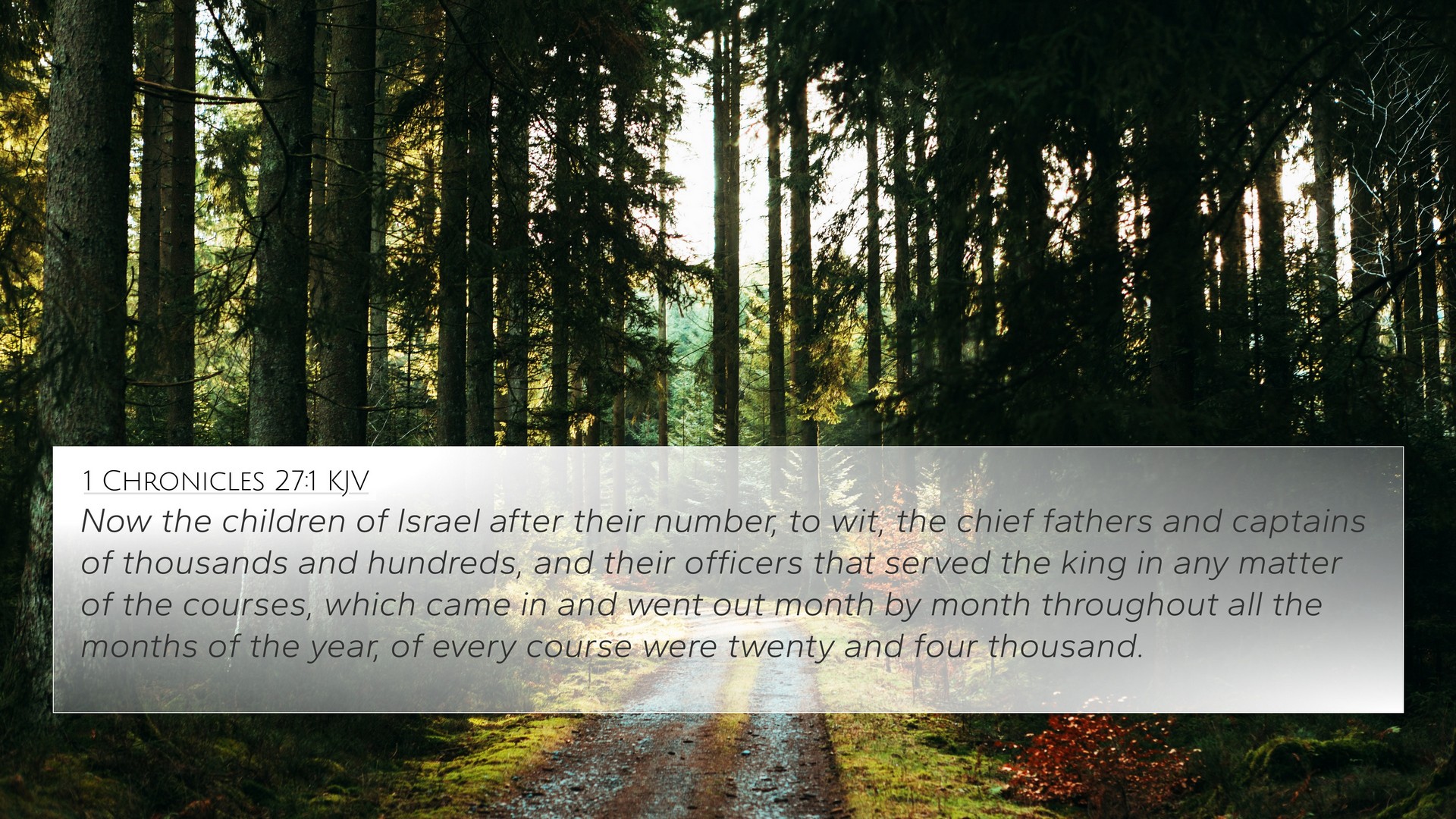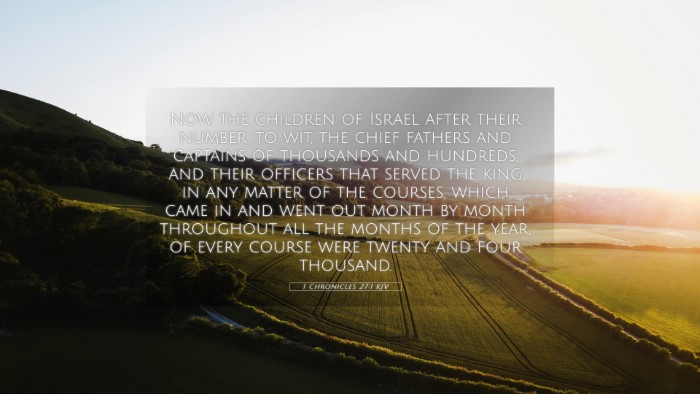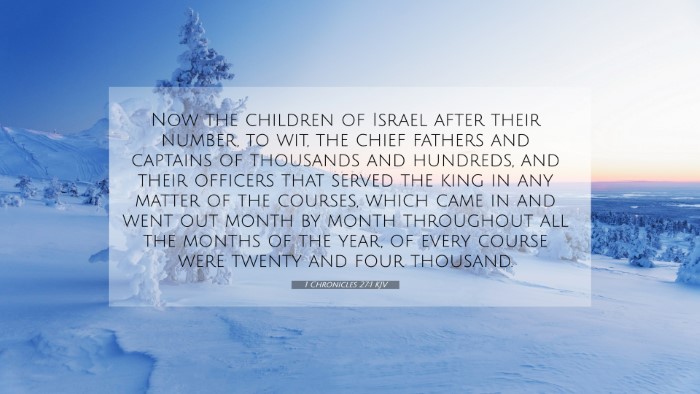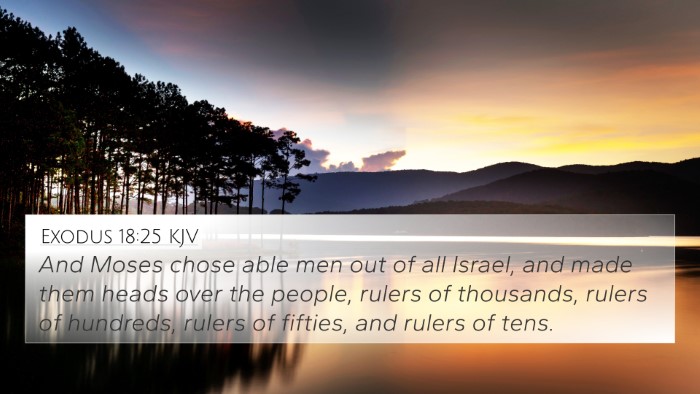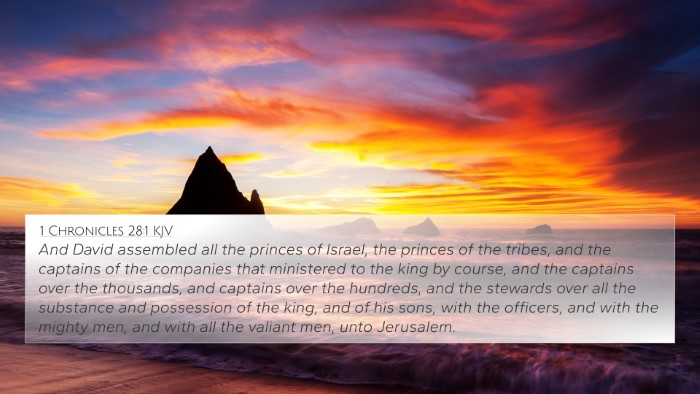Understanding 1 Chronicles 27:1
Verse: "Now the children of Israel after their number, to wit, the chief fathers and captains of thousands and hundreds, and their officers that served the king in any matter of the courses, which came in and went out month by month throughout all the months of the year, of every course were twenty and four thousand." (1 Chronicles 27:1 KJV)
Summary of Meaning
The verse outlines a systematic approach to governance and military organization under King David's rule. It indicates that the children of Israel were counted and organized into courses or divisions, focusing on the leadership responsibilities of various tribes and families.
Insights from Commentaries
-
Matthew Henry:
Henry emphasizes the structure of David’s government, noting that he arranged his forces into distinct divisions. This highlights David's wisdom in administration, ensuring that the people served effectively in their capacities.
-
Albert Barnes:
Barnes elaborates on the importance of this organization for maintaining order and readiness. He points out that the numbering of individuals reflects a deliberate effort to know the resources at the king's disposal and to prepare them for each month of service.
-
Adam Clarke:
Clarke discusses the significance of the total number of men listed and how they were arranged by their families. This organization is vital for both military and civil responsibilities, signifying the communal effort in serving their nation under a holy king.
Key Themes
This verse touches upon various important themes that are echoed throughout the Bible:
- Leadership and Governance: It shows the structure of leadership in Israel and God's expectation for order.
- Identity and Community: The counting and organization foster a sense of community and identity among the tribes of Israel.
- Readiness and Service: The emphasis on monthly courses implies a need for constant preparation and readiness for service.
Cross-References
1 Chronicles 27:1 can be cross-referenced with several other biblical texts that reinforce its themes:
- 1 Samuel 8:20: Reflects the desire for a structured leadership.
- 2 Samuel 24:2: Discusses the military census taken by David.
- 1 Chronicles 22:2: Describes the organization of workers for the temple.
- Exodus 18:21: Highlights the establishment of wise leaders among the people.
- Numbers 1:2: Refers to the census taken of the people in the wilderness.
- 1 Chronicles 12:1-22: Discusses the gathering of warriors under David's leadership.
- 2 Chronicles 2:2: Continues the theme of organizing the work of the temple.
- Matthew 10:1: Jesus similarly organizes His disciples for service.
- 1 Corinthians 12:12-27: Talks about the body of Christ and its organized nature.
- Philippians 1:5: Mentions partnership in ministry, reflecting organized service in the church.
Conclusion
In conclusion, 1 Chronicles 27:1 reveals important principles about governance, organization, and the roles of individuals within a community. The insights from commentaries emphasize the wisdom of structure in leadership, while the cross-references provide a broader context to understand these themes throughout the scripture.
For those interested in deeper study, exploring Bible concordances and reference guides can enhance understanding of how these themes interconnect across the entire biblical narrative. The act of cross-referencing not only enriches personal study but can also facilitate sermon preparation and deeper insights into the character of God as seen through the organization of His people.
Cross-Referencing Tools
Utilizing tools for Bible cross-referencing can greatly aid in thematic connections. Here are some methods and resources:
- Bible Concordance: A resource that lists words and their references, enabling the identification of related verses.
- Bible Cross-Reference Guide: Helps trace thematic links between scriptures.
- Cross-Reference Bible Study: A method to understand the connections and parallels within biblical texts.
- Bible Chain References: A technique for following themes through linked verses.
